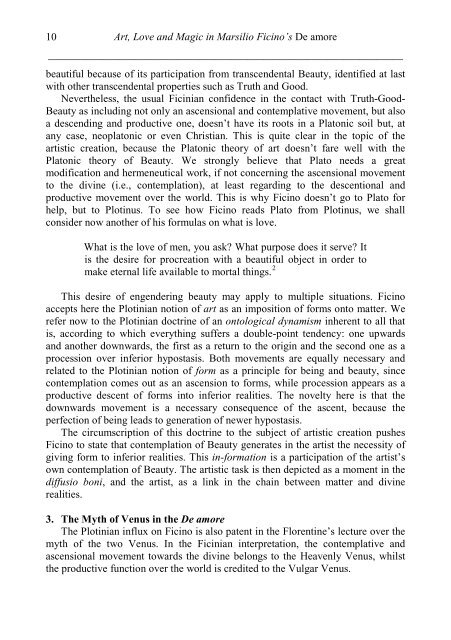Magic and the Supernatural - Lancaster University
Magic and the Supernatural - Lancaster University
Magic and the Supernatural - Lancaster University
You also want an ePaper? Increase the reach of your titles
YUMPU automatically turns print PDFs into web optimized ePapers that Google loves.
10<br />
Art, Love <strong>and</strong> <strong>Magic</strong> in Marsilio Ficino’s De amore<br />
__________________________________________________________________<br />
beautiful because of its participation from transcendental Beauty, identified at last<br />
with o<strong>the</strong>r transcendental properties such as Truth <strong>and</strong> Good.<br />
Never<strong>the</strong>less, <strong>the</strong> usual Ficinian confidence in <strong>the</strong> contact with Truth-Good-<br />
Beauty as including not only an ascensional <strong>and</strong> contemplative movement, but also<br />
a descending <strong>and</strong> productive one, doesn’t have its roots in a Platonic soil but, at<br />
any case, neoplatonic or even Christian. This is quite clear in <strong>the</strong> topic of <strong>the</strong><br />
artistic creation, because <strong>the</strong> Platonic <strong>the</strong>ory of art doesn’t fare well with <strong>the</strong><br />
Platonic <strong>the</strong>ory of Beauty. We strongly believe that Plato needs a great<br />
modification <strong>and</strong> hermeneutical work, if not concerning <strong>the</strong> ascensional movement<br />
to <strong>the</strong> divine (i.e., contemplation), at least regarding to <strong>the</strong> descentional <strong>and</strong><br />
productive movement over <strong>the</strong> world. This is why Ficino doesn’t go to Plato for<br />
help, but to Plotinus. To see how Ficino reads Plato from Plotinus, we shall<br />
consider now ano<strong>the</strong>r of his formulas on what is love.<br />
What is <strong>the</strong> love of men, you ask? What purpose does it serve? It<br />
is <strong>the</strong> desire for procreation with a beautiful object in order to<br />
make eternal life available to mortal things. 2<br />
This desire of engendering beauty may apply to multiple situations. Ficino<br />
accepts here <strong>the</strong> Plotinian notion of art as an imposition of forms onto matter. We<br />
refer now to <strong>the</strong> Plotinian doctrine of an ontological dynamism inherent to all that<br />
is, according to which everything suffers a double-point tendency: one upwards<br />
<strong>and</strong> ano<strong>the</strong>r downwards, <strong>the</strong> first as a return to <strong>the</strong> origin <strong>and</strong> <strong>the</strong> second one as a<br />
procession over inferior hypostasis. Both movements are equally necessary <strong>and</strong><br />
related to <strong>the</strong> Plotinian notion of form as a principle for being <strong>and</strong> beauty, since<br />
contemplation comes out as an ascension to forms, while procession appears as a<br />
productive descent of forms into inferior realities. The novelty here is that <strong>the</strong><br />
downwards movement is a necessary consequence of <strong>the</strong> ascent, because <strong>the</strong><br />
perfection of being leads to generation of newer hypostasis.<br />
The circumscription of this doctrine to <strong>the</strong> subject of artistic creation pushes<br />
Ficino to state that contemplation of Beauty generates in <strong>the</strong> artist <strong>the</strong> necessity of<br />
giving form to inferior realities. This in-formation is a participation of <strong>the</strong> artist’s<br />
own contemplation of Beauty. The artistic task is <strong>the</strong>n depicted as a moment in <strong>the</strong><br />
diffusio boni, <strong>and</strong> <strong>the</strong> artist, as a link in <strong>the</strong> chain between matter <strong>and</strong> divine<br />
realities.<br />
3. The Myth of Venus in <strong>the</strong> De amore<br />
The Plotinian influx on Ficino is also patent in <strong>the</strong> Florentine’s lecture over <strong>the</strong><br />
myth of <strong>the</strong> two Venus. In <strong>the</strong> Ficinian interpretation, <strong>the</strong> contemplative <strong>and</strong><br />
ascensional movement towards <strong>the</strong> divine belongs to <strong>the</strong> Heavenly Venus, whilst<br />
<strong>the</strong> productive function over <strong>the</strong> world is credited to <strong>the</strong> Vulgar Venus.

















